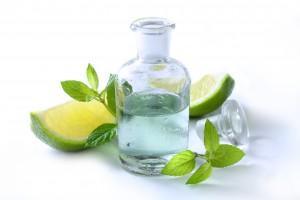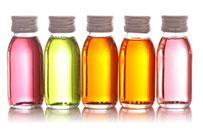 Most fragrances are a combination of many aromatic ingredients. These ingredients are derived from nature or created by scientific methods. Natural Ingredients include essential oils, resins, and absolutes.
Most fragrances are a combination of many aromatic ingredients. These ingredients are derived from nature or created by scientific methods. Natural Ingredients include essential oils, resins, and absolutes.
Natural Ingredients:
AROMATIC ESSENTIAL OILS are derived from plants using either distillation or cold pressing. They are generally in liquid form. An essential oil from one plant can vary in color, odor, and price depending on the crop from which the oil is derived. Mother Nature rules here and variations between lots of the same oil must be assessed for suitability. And, not all plants yield aromatic essential oils.
Examples of Aromatic Essential Oils are: Orange Oil, Lavender Oil, Patchouli Oil, Cedar Wood Oil
RESINS are materials which are exuded from a plant when the other layer of the plant is cut. They are dense and sticky and may solidify into a solid mass. Heat may be required to melt some resins. Resins are long lasting fragrance ingredients. Examples: Myrrh resin, Benzoin resin, Fir resin, Oakmoss resin, Copel Resin Tears.
ABSOLUTES are created by removing the aromatic components from plants which cannot yield essential oils. Many plants are too fragile to be distilled; therefore the absolute is the form in which we capture the aromatic components of the plant. The absolute is highly concentrated and somewhat viscous. Now, the yield of absolute material per plant is exceptionally small, and the processing is very labor intensive. As a result, absolutes are usually very expensive.
Examples: Rose absolute, Orange flower absolute, Jasmine absolute, Narcisse absolute.
Manmade Ingredients include aromatic ingredients in liquid, crystalline, or powder form. Commonly called chemicals, manmade fragrance ingredients produce a wide variety of aromatic sensations. Some of these ingredients are also found in nature, but science can reproduce them synthetically. The synthetic versions are generally less expensive, more consistent in odor and color and widely available.
Aromatic chemicals offer the perfumer a vast palette of materials to compliment natural ingredients. They help control the cost of a fragrance and help ensure consistent quality. Many aromatic chemicals can create intense, unusual or dramatic effects in a fragrance. Most fragrances are a combination of the natural and synthetic ingredients. The perfumer will choose materials based on odor, cost, and stability in the product being scented.
Examples of manmade aromatic materials: citral, linalyl, acetate, phenyl, ethyl, vanillin.
These ingredients form Fragrance Oils.
Parts of a Fragrance Oil
A fragrance oil is divided into 3 distinct parts. The top note, the middle note, and the base note. Each of these usually has an assortment of ingredients.
Top notes are the most volatile fragrance ingredients. The top notes give the fragrance its initial burst and can provide impact in a finished product. Top notes are the first to evaporate, leaving the middle notes of the fragrance to be explored. Traditional top notes include citrus oil and light aromatic chemicals such as esters.
Middle notes are also called the fragrance heart. They represent the true fragrance character. The middle notes are longer lasting than the top notes. These ingredients form the fragrance signature and are evident throughout most of the life of the fragrance. Typical middle notes include floral, spice, and fruit tones.
Base Notes are also called the bottom notes or dry down. Base notes are the longest lasting components of the fragrance. These ingredients support the fragrance and give it depth. Base notes remain long after the top and middle notes have evaporated. Perfumists use base notes to anchor the volatile fragrance notes in a fragrance. Commonly used materials for base notes are musk, vanilla, resins, and woods.

